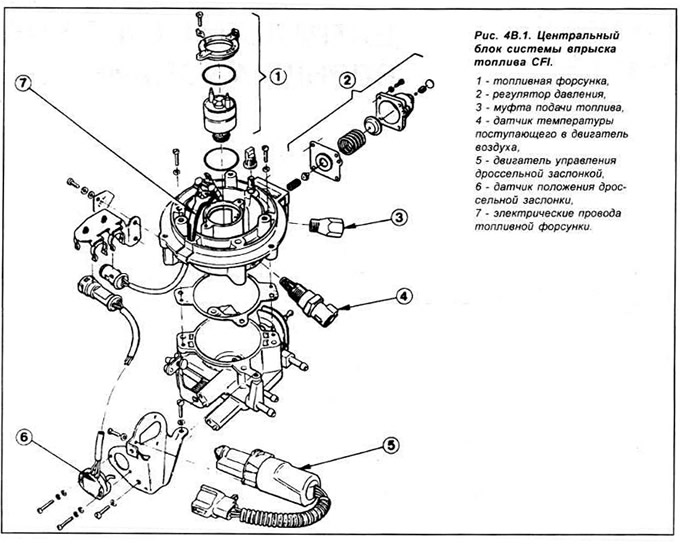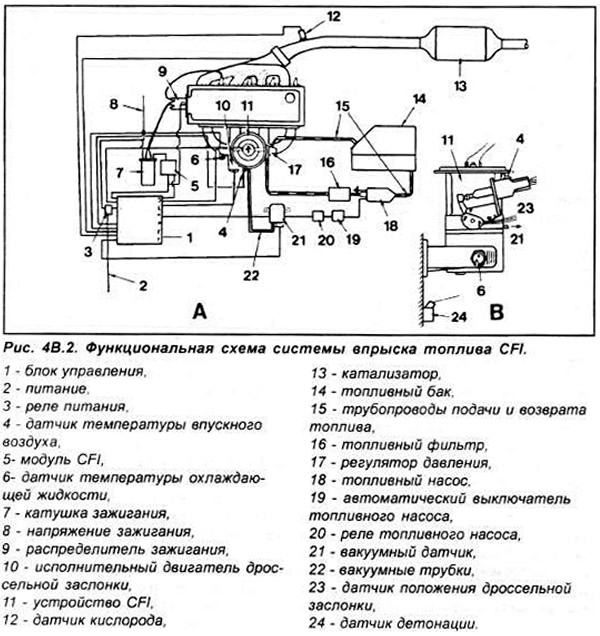
Fuel injection is performed by a fuel injector, which is installed in the central upper part of the injector. The fuel injector is controlled by an electronic engine control unit (ECU). When the fuel injector is open, pressurized fuel enters the intake manifold. The fuel injector is controlled by a voltage of different magnitudes. A high voltage is required to open the injector, and a reduced voltage is required to hold the injector open.

The air-fuel ratio is controlled by the engine control ECU based on data from sensors mounted on the engine. Manual adjustment of the mixture quality is not possible. Throttle control motor (mounted on the side of the injector) regulates the idle speed in response to signals received from the ECU If the throttle position sensor indicates that the throttle is closed, the ECU will bring the engine to idle. The ECU maintains idle speed and makes minor adjustments as needed based on engine load.
The idle speed can only be adjusted by a fuel injection specialist with the necessary equipment. To prevent glow plug engine operation when the engine is turned off, the ECU sends a signal to the throttle control motor, which fully closes the throttle and then returns it to the position required to start the engine. When the ignition is turned on before starting the engine, the throttle control motor moves it to a position that allows the engine to start normally. The ECU is the main engine control unit that controls the fuel injection system, ignition and exhaust emissions. The ECU receives information from various sensors and determines the temperature engine speed and load, as well as the amount of air entering the engine.
The sensors also provide the ECU with relative throttle position, engine air temperature, and exhaust oxygen content. Based on the information received from the sensors, the ECU determines the fuel injection period. Information about the revolutions of the crankshaft is transmitted to the ECU by the crank angle sensor. The sensor is an inductive pulse generator located on the cylinder block that induces a signal when the ridges pass between the 36 holes located on the inside of the flywheel.
Since when passing each ridge near the sensor. a signal is induced which is used by the ECU to determine the engine speed. There are no ridges between holes 35 and 36, resulting in a missing signal to the ECU. As a result, the ECU determines the position of the crankshaft. A temperature sensor is used to determine the temperature of the engine. It's a thermistor (with negative temperature coefficient), those semiconductors whose electrical resistance decreases with increasing temperature.
Information about the temperature of the air entering the engine is transmitted to the air temperature sensor, which is a thermistor with a negative coefficient of resistance. The throttle position sensor is located at the end of the throttle shaft and provides the ECU with a constantly changing analog voltage signal. corresponding to the opening of the throttle valve. The vehicle speed is determined by the speed sensor. which is installed on the speedometer drive. The MAP sensor measures intake manifold vacuum and feeds this information to the ECU to determine engine load at any throttle position. Power steering uses a pressure sensor installed in the steering system. The ECU increases the idle speed until until the pressure in the steering system reaches the required value. The oxygen sensor is located in the exhaust system and serves as a feedback, based on which the quality of the mixture is adjusted in order to provide optimal conditions for the catalyst.
Precautions
Do not start the engine with loose terminals on the battery. Do not disconnect the battery while the engine is running.
When charging the battery from the charger, disconnect both battery terminals from the car's on-board network. Do not use a quick charger to start the engine. At temperatures above 80°C (drying after painting) remove the electronic control unit.
Do not disconnect or connect the ECU connector with the ignition on. Disconnect power to the fuel pump relay when checking compression. The power system is under pressure. therefore, the pressure must be relieved before replacing parts of the system. If the engine has not been running for several hours, the pressure in the fuel system will drop by itself.
Visitor comments